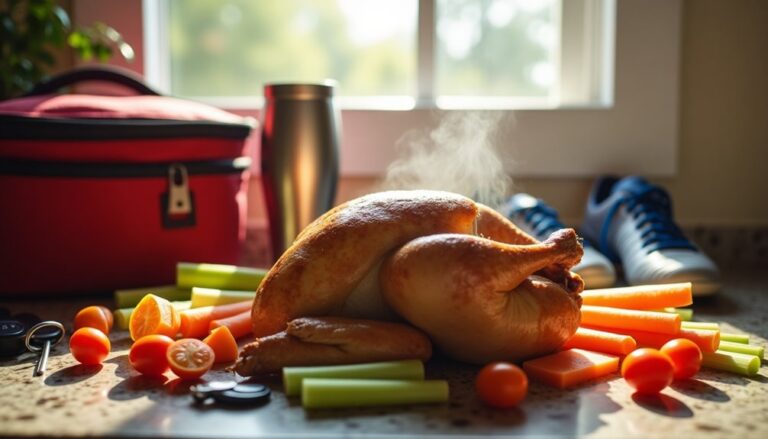15 Easy Low FODMAP Recipes
If you're following a low FODMAP diet, you'll be glad to know that eating well doesn't have to be complicated or bland. These 15 easy recipes offer you a practical way to manage your digestive health while enjoying satisfying meals throughout the day. From the protein-rich Quinoa Breakfast Scramble to the Mediterranean-inspired dishes, each recipe has been carefully crafted to minimize trigger ingredients. Let's explore how these kitchen-tested recipes can transform your daily menu into something both gut-friendly and delicious.
Low FODMAP Maple Oatmeal Bowl
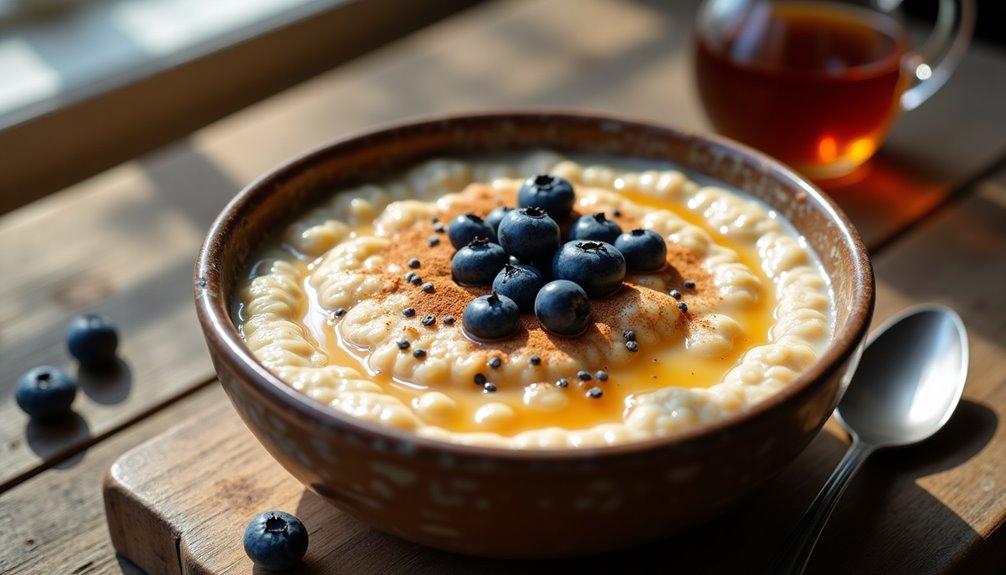
Starting your day with a warm bowl of maple oatmeal can be both comforting and gut-friendly when following a low FODMAP diet. This simple breakfast recipe provides sustained energy while being gentle on sensitive digestive systems, making it an ideal choice for those managing IBS or similar conditions.
Traditional oatmeal recipes often include high FODMAP ingredients like honey, regular milk, or certain fruits. This version uses maple syrup as a natural sweetener and lactose-free milk to create a creamy, satisfying breakfast that adheres to low FODMAP guidelines while maintaining the classic flavors we love in a morning bowl of oats.
Ingredients:
- 1 cup gluten-free rolled oats
- 2 cups lactose-free milk
- 2 tablespoons pure maple syrup
- 1/4 teaspoon cinnamon
- 1/8 teaspoon salt
- 1/2 cup blueberries (optional)
- 1 tablespoon chia seeds (optional)
Combine the rolled oats and lactose-free milk in a medium saucepan over medium heat. Add salt and bring to a gentle simmer, stirring occasionally. Reduce heat to low and cook for 5-7 minutes, stirring frequently until the oats reach your desired consistency. Remove from heat and stir in the maple syrup and cinnamon.
For best results, avoid using instant oats as they can become too mushy. The thickness of the oatmeal can be adjusted by adding more lactose-free milk during cooking. For added texture and nutrition, top with low FODMAP fruits like blueberries or strawberries, and sprinkle with chia seeds just before serving.
Quick Quinoa Breakfast Scramble
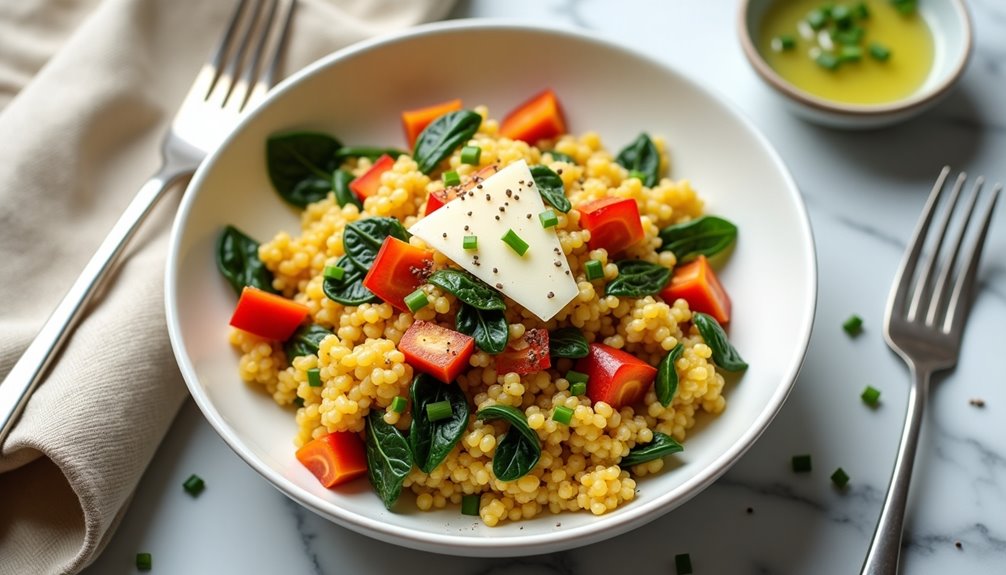
Quick Quinoa Breakfast Scramble is a protein-rich, low FODMAP alternative to traditional breakfast dishes. This satisfying meal combines fluffy quinoa with scrambled eggs and low FODMAP vegetables, creating a nutritious start to your day that won't trigger digestive issues.
This versatile recipe can be prepared in advance by cooking the quinoa the night before, making it perfect for busy mornings. The combination of quinoa and eggs provides complete protein, while the vegetables add essential nutrients and a pleasant texture contrast.
Ingredients:
- 1 cup cooked quinoa
- 4 large eggs
- 1 cup spinach leaves
- 1/2 red bell pepper, diced
- 2 tablespoons chives, finely chopped
- 2 tablespoons olive oil
- 1/4 teaspoon salt
- 1/4 teaspoon black pepper
- 1/4 cup grated hard cheese (optional)
Heat olive oil in a large skillet over medium heat. Add diced bell peppers and cook for 2-3 minutes until slightly softened. Add the cooked quinoa to the pan and stir to combine. Beat the eggs in a separate bowl with salt and pepper, then pour into the skillet. Gently stir while the eggs cook, and when they're almost set, add the spinach and chives. Continue cooking until the eggs are completely set and the spinach has wilted. If using cheese, sprinkle it on top and let it melt slightly before serving.
For best results, ensure the quinoa is completely cooled before adding it to the scramble to prevent it from becoming mushy. The dish can be stored in an airtight container in the refrigerator for up to two days, though it's best enjoyed fresh. To reheat, use a microwave at 50% power to prevent the eggs from becoming rubbery.
Grilled Chicken and Rice Bowl

Grilled chicken and rice bowls are a perfect low FODMAP meal that combines lean protein with satisfying carbohydrates. This versatile dish can be customized with various low FODMAP vegetables and seasonings while maintaining its gut-friendly properties.
This recipe serves four people and takes approximately 30 minutes to prepare. The combination of marinated grilled chicken and fluffy rice creates a filling meal that's both nutritious and easy on sensitive digestive systems.
- 4 chicken breasts
- 2 cups white rice
- 4 cups water
- 2 tablespoons olive oil
- 1 tablespoon lemon juice
- 1 teaspoon dried oregano
- 1 teaspoon paprika
- ½ teaspoon salt
- ¼ teaspoon black pepper
- 2 cups baby spinach
- 1 cup cherry tomatoes
- 1 tablespoon fresh parsley
Start by marinating the chicken breasts in olive oil, lemon juice, oregano, paprika, salt, and pepper for at least 15 minutes. While the chicken marinates, rinse the rice thoroughly and cook it in a rice cooker or on the stovetop with 4 cups of water until fluffy. Heat your grill or grill pan to medium-high heat and cook the chicken for 6-7 minutes per side, or until the internal temperature reaches 165°F (74°C).
Once the chicken is cooked, let it rest for 5 minutes before slicing. Assemble the bowls by dividing the rice among four bowls, topping each with sliced chicken, fresh baby spinach, and halved cherry tomatoes. Garnish with fresh parsley.
For best results, avoid overcooking the chicken as it can become dry. The rice can be made ahead of time and reheated, making this an excellent meal prep option. If you're sensitive to certain seasonings, adjust the herbs and spices according to your tolerance levels. Store any leftovers in an airtight container in the refrigerator for up to 3 days.
Simple Sourdough Avocado Toast

Sourdough bread is naturally low FODMAP due to the fermentation process, making it an excellent base for this classic breakfast or brunch dish. When paired with perfectly ripe avocado, this simple yet satisfying meal provides healthy fats and complex carbohydrates to fuel your day.
While traditional avocado toast recipes often include garlic or onion, this low FODMAP version focuses on clean, simple flavors enhanced with lemon juice and optional seasonings that won't trigger digestive discomfort. The key is using properly ripened avocados and high-quality sourdough bread for the best taste and texture.
- 2 slices sourdough bread
- 1 medium ripe avocado
- 1 tablespoon lemon juice
- 1/4 teaspoon sea salt
- 1/8 teaspoon black pepper
- Optional: red pepper flakes
- Optional: 2 eggs (for topping)
- Optional: microgreens or fresh herbs
Toast the sourdough bread slices until golden brown and crispy. While the bread is toasting, cut the avocado in half, remove the pit, and scoop the flesh into a bowl. Mash the avocado with a fork until it reaches your desired consistency, then add lemon juice, salt, and pepper, mixing well to combine.
Spread the seasoned avocado mixture evenly over the toasted sourdough slices. If desired, top with a fried or poached egg, sprinkle with red pepper flakes, or garnish with microgreens. Serve immediately while the toast is still warm and crispy.
For best results, choose avocados that yield slightly when gently pressed but aren't too soft. Store unripe avocados at room temperature until they reach ideal ripeness, then refrigerate to slow the ripening process. The lemon juice not only adds flavor but also helps prevent the avocado from browning too quickly, though this dish is best enjoyed immediately after preparation.
Mediterranean Tuna Salad
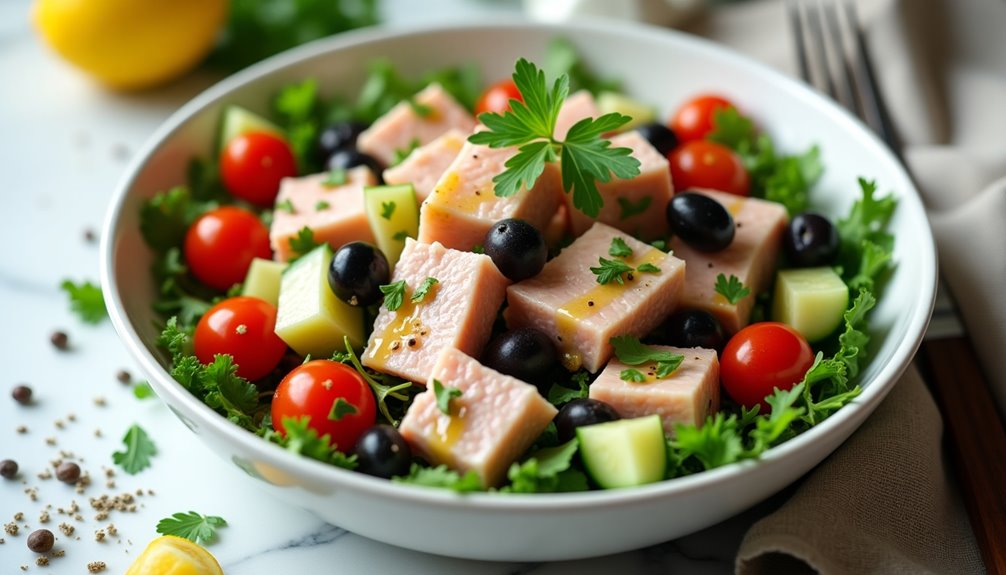
Mediterranean Tuna Salad is a refreshing and protein-rich dish that perfectly aligns with the low FODMAP diet while delivering the vibrant flavors of Mediterranean cuisine. This simple yet satisfying salad combines lean tuna with crisp vegetables and a zesty lemon dressing, making it an ideal choice for lunch or a light dinner.
The beauty of this recipe lies in its versatility and quick preparation time. While traditional Mediterranean salads often include onions and garlic, this modified version maintains authentic flavors through carefully selected low FODMAP ingredients, ensuring digestive comfort without compromising taste.
Ingredients:
- 2 cans (5 oz each) low FODMAP tuna in water, drained
- 1 cup cherry tomatoes, halved
- 1 cup cucumber, diced
- 1/2 cup kalamata olives, pitted
- 1/4 cup fresh parsley, chopped
- 2 tablespoons capers, drained
- 3 tablespoons extra virgin olive oil
- 2 tablespoons fresh lemon juice
- 1 teaspoon dried oregano
- 1/2 teaspoon sea salt
- 1/4 teaspoon black pepper
- 2 cups mixed salad greens
Drain the tuna thoroughly and break it into chunks in a large mixing bowl. Add the halved cherry tomatoes, diced cucumber, kalamata olives, chopped parsley, and capers to the bowl. In a separate small bowl, whisk together the olive oil, lemon juice, dried oregano, salt, and pepper until well combined.
Pour the dressing over the tuna mixture and gently toss all ingredients together until evenly distributed. Arrange the mixed salad greens on a serving plate or in individual bowls, then top with the tuna mixture. Let the salad rest for 5-10 minutes before serving to allow the flavors to meld together.
For best results, use tuna packed in water rather than oil to better control the final flavor and texture of the salad. The salad can be prepared up to 24 hours in advance, but add the greens just before serving to maintain their crispness. If making ahead, store the dressed tuna mixture and greens separately in airtight containers in the refrigerator.
Lemon Herb Baked Salmon

Lemon and herb baked salmon is a delicious and nutritious low FODMAP meal that's perfect for both weeknight dinners and special occasions. The natural oils in salmon complement the bright citrus notes and aromatic herbs, creating a dish that's both flavorful and gentle on sensitive digestive systems.
This recipe takes only 20 minutes to prepare and cook, making it an ideal choice for busy individuals following a low FODMAP diet. The combination of fresh herbs and lemon ensures the salmon remains moist while developing a perfectly crispy exterior during baking.
- 4 salmon fillets (6 oz each)
- 2 tablespoons olive oil
- 2 tablespoons fresh lemon juice
- 2 teaspoons fresh dill, chopped
- 2 teaspoons fresh parsley, chopped
- 1 teaspoon fresh thyme leaves
- ½ teaspoon kosher salt
- ¼ teaspoon black pepper
- 1 lemon, sliced
- Parchment paper
Preheat the oven to 400°F (200°C). Place the salmon fillets on a baking sheet lined with parchment paper.
In a small bowl, combine olive oil, lemon juice, dill, parsley, thyme, salt, and pepper. Brush this mixture evenly over the salmon fillets, making sure to coat all sides. Place lemon slices on top of each fillet.
Bake the salmon for 12-15 minutes, or until it flakes easily with a fork and reaches an internal temperature of 145°F (63°C). The cooking time may vary slightly depending on the thickness of your fillets.
For best results, let the salmon rest at room temperature for 15-20 minutes before cooking to ensure even baking. If using frozen salmon, make sure it's completely thawed and patted dry with paper towels before adding the herb mixture. The herbs can be adjusted according to availability and preference, but stick to low FODMAP options like basil, oregano, or chives as alternatives.
Turkey and Spinach Stir-Fry
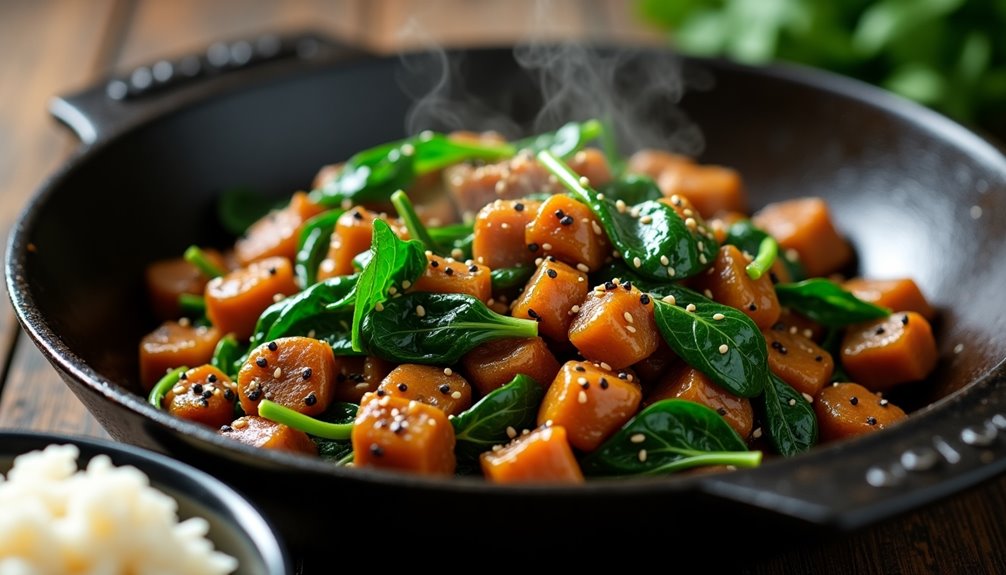
A quick and satisfying low FODMAP dinner option, this Turkey and Spinach Stir-Fry combines lean protein with nutritious greens in a flavorful Asian-inspired sauce. The dish comes together in under 30 minutes, making it perfect for busy weeknight meals while adhering to FODMAP-friendly dietary requirements.
This recipe avoids common FODMAP triggers like garlic and onions, instead relying on ginger, sesame oil, and wheat-free tamari sauce for depth of flavor. The combination of ground turkey and fresh spinach provides a good balance of protein and iron, while keeping the dish light and digestible.
- 1 pound ground turkey
- 6 cups fresh spinach
- 2 tablespoons sesame oil
- 2 tablespoons wheat-free tamari sauce
- 1 tablespoon rice vinegar
- 1 tablespoon fresh ginger, grated
- 1 tablespoon cornstarch
- 1/4 cup water
- 1/2 teaspoon black pepper
- Salt to taste
- 2 cups cooked rice (optional, for serving)
Heat sesame oil in a large skillet or wok over medium-high heat. Add ground turkey and break it up with a wooden spoon, cooking until no longer pink, about 5-7 minutes. Add grated ginger and continue cooking for another minute. In a small bowl, whisk together tamari sauce, rice vinegar, cornstarch, and water until smooth. Pour the sauce mixture into the pan with the turkey and stir to combine.
Add fresh spinach to the pan in batches, allowing each addition to wilt before adding more. Season with black pepper and salt to taste. Continue cooking for 2-3 minutes until the sauce has thickened and the spinach is completely wilted but still bright green. Serve hot over rice if desired.
For best results, ensure all ingredients are room temperature before cooking, as cold ingredients can lower the pan temperature and result in soggy stir-fry. The cornstarch can be adjusted for a thicker or thinner sauce according to preference. Leftovers can be stored in an airtight container in the refrigerator for up to 3 days, though the spinach may lose some of its vibrant color.
Easy Zucchini Noodle Pasta
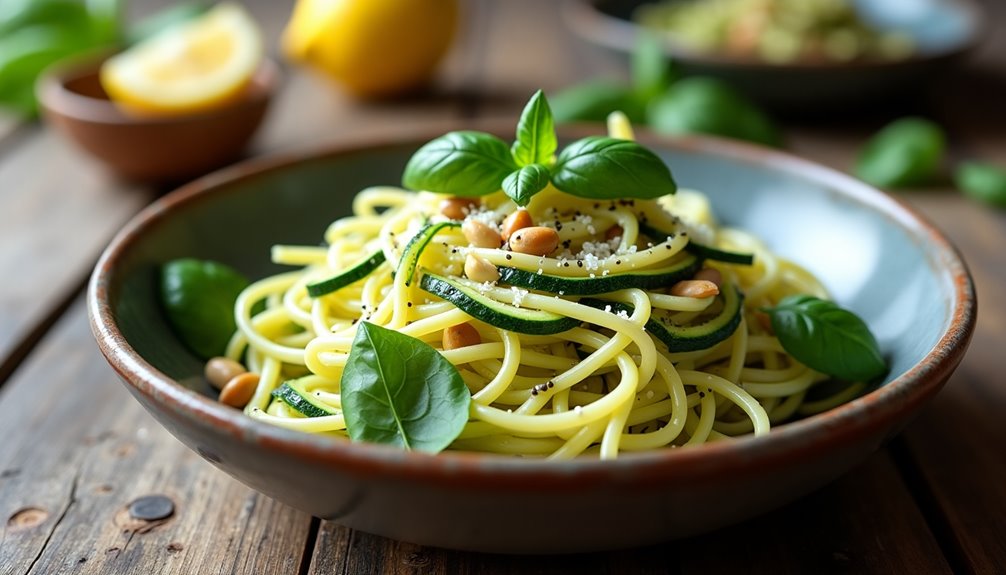
Zucchini noodles, also known as "zoodles," offer a delicious low-FODMAP alternative to traditional pasta. This versatile dish provides a perfect base for those following a low-FODMAP diet while still enjoying the comfort of a pasta-like meal. The spiralized zucchini creates tender noodles that maintain their shape and texture when cooked properly.
This recipe combines fresh zucchini with simple seasonings and optional protein additions to create a satisfying main course. The dish comes together quickly, making it an excellent choice for busy weeknight dinners or when you're craving a light yet filling meal that won't trigger digestive discomfort.
Ingredients:
- 4 medium zucchini
- 2 tablespoons olive oil
- 2 cloves garlic-infused oil
- 1/2 teaspoon salt
- 1/4 teaspoon black pepper
- 1/4 cup fresh basil leaves
- 2 tablespoons pine nuts
- 1/4 cup grated parmesan cheese (optional)
- 1 tablespoon lemon juice
Using a spiralizer, create zucchini noodles from your fresh zucchini. Heat olive oil in a large skillet over medium heat. Add the zucchini noodles and cook for 3-4 minutes, tossing occasionally with tongs. Add the garlic-infused oil, salt, and pepper, continuing to cook for another 2-3 minutes until the noodles are tender but still slightly firm. Remove from heat and stir in fresh basil, pine nuts, and optional parmesan cheese. Finish with a squeeze of lemon juice before serving.
For best results, avoid overcooking the zucchini noodles as they can become mushy and release excess water. If your zoodles seem watery after spiralizing, lay them on paper towels and sprinkle with salt for 10 minutes before cooking to draw out excess moisture. This step helps achieve the perfect texture in your final dish.
Rice Paper Spring Rolls

Rice paper spring rolls are a refreshing and FODMAP-friendly appetizer that's perfect for warm days or as a light meal. These rolls are naturally gluten-free and can be customized with various low FODMAP vegetables and proteins to suit your dietary needs.
The key to successful spring rolls lies in the preparation and organization of ingredients before assembly. Rice paper wrappers become sticky when wet, so having all components ready and a clean workspace is essential for smooth rolling.
Ingredients:
- 8 rice paper wrappers
- 2 cups cooked rice vermicelli noodles
- 1 cup shredded carrots
- 1 cup cucumber, julienned
- 1 cup fresh lettuce leaves
- 1 cup bean sprouts
- 8 large shrimp, cooked and halved lengthwise (optional)
- Fresh mint leaves
- Fresh cilantro leaves
- Warm water for dipping
Fill a large, shallow bowl with warm water. Working one at a time, dip a rice paper wrapper in the warm water for about 5 seconds until it starts to soften. Place the wrapper on a clean, damp kitchen towel. Layer your ingredients in the lower third of the wrapper, starting with lettuce, followed by noodles, vegetables, herbs, and shrimp if using.
Fold the bottom of the wrapper over the filling, then fold in the sides. Continue rolling tightly until sealed, similar to wrapping a burrito. Place finished rolls on a plate lined with damp paper towels to prevent sticking. Repeat with remaining wrappers and filling ingredients.
For best results, serve the spring rolls immediately or within a few hours of preparation. Store them separately without touching, as they can stick together. Cover with damp paper towels and plastic wrap if not serving right away. Avoid refrigeration as this can make the rice paper tough and chewy.
Baked Potato Wedges With Herbs

Baked potato wedges are a delicious, low FODMAP alternative to regular french fries. These crispy, golden-brown wedges are seasoned with herbs and spices that add flavor without triggering digestive sensitivities common in high FODMAP foods.
This recipe creates perfectly crispy wedges on the outside while maintaining a soft, fluffy interior. The combination of dried herbs and olive oil ensures the potatoes develop a beautiful crust during baking, making them an excellent side dish for any meal or a satisfying snack on their own.
Ingredients:
- 4 large russet potatoes
- 3 tablespoons olive oil
- 1 teaspoon dried rosemary
- 1 teaspoon dried thyme
- 1 teaspoon paprika
- 1/2 teaspoon salt
- 1/4 teaspoon black pepper
- 1/4 teaspoon garlic-infused oil (optional)
Preheat your oven to 425°F (220°C) and line a large baking sheet with parchment paper. Wash and dry the potatoes thoroughly, then cut them lengthwise into wedges of equal size. Place the wedges in a large bowl and toss them with olive oil, herbs, and seasonings until evenly coated.
Arrange the potato wedges on the prepared baking sheet, ensuring they're not touching each other. Bake for 35-40 minutes, flipping them halfway through the cooking time. The wedges are done when they're golden brown and crispy on the outside, and you can easily pierce them with a fork.
For best results, soak the cut potato wedges in cold water for 30 minutes before cooking to remove excess starch, then dry them thoroughly. This step helps achieve maximum crispiness. Also, avoid overcrowding the baking sheet, as this can cause the potatoes to steam rather than roast, resulting in less crispy wedges.
Low FODMAP Chicken Soup
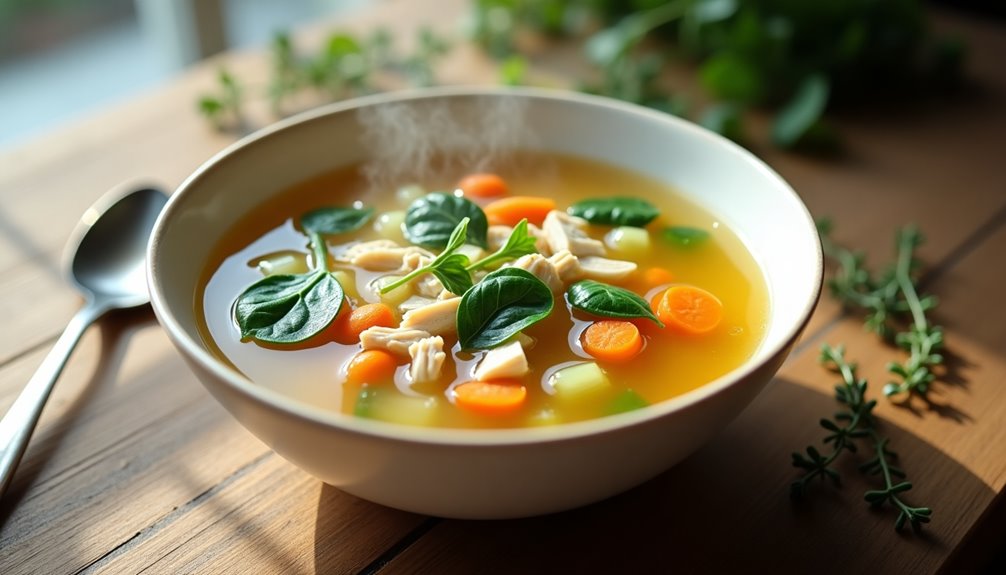
Low FODMAP chicken soup is a comforting and healing dish that can be safely enjoyed by those following a FODMAP-restricted diet. This classic recipe eliminates common trigger ingredients like onions and garlic while maintaining rich, satisfying flavors through the use of FODMAP-friendly alternatives.
This version features tender chicken, carrots, and celery in a flavorful broth seasoned with herbs and spices. The recipe isn't only easy to prepare but also freezes well, making it perfect for meal prep or having on hand during flare-ups.
- 2 pounds chicken breasts, skinless
- 8 cups water
- 2 medium carrots, sliced
- 2 celery stalks, chopped
- 1 tablespoon olive oil
- 1 tablespoon fresh ginger, grated
- 1 teaspoon dried thyme
- 1 teaspoon dried oregano
- 2 bay leaves
- 1 cup fresh spinach
- Salt and pepper to taste
- Optional: 1 cup gluten-free pasta
Heat olive oil in a large pot over medium heat. Add chicken breasts and cook until lightly browned on both sides, about 5 minutes per side. Add water, carrots, celery, ginger, and herbs to the pot. Bring to a boil, then reduce heat and simmer for 25-30 minutes until chicken is fully cooked.
Remove chicken from the pot and shred it using two forks. Return the shredded chicken to the pot and add spinach. If using pasta, add it now and cook according to package instructions. Season with salt and pepper to taste. Continue simmering for an additional 5 minutes until all ingredients are heated through and spinach is wilted.
For best results, store this soup in an airtight container in the refrigerator for up to 4 days, or freeze for up to 3 months. If adding pasta, consider cooking and storing it separately to prevent it from becoming too soft when reheating. The soup can be customized with other low FODMAP vegetables like zucchini or bell peppers, but be sure to check current FODMAP guidelines for proper portions.
Quinoa and Roasted Vegetable Bowl
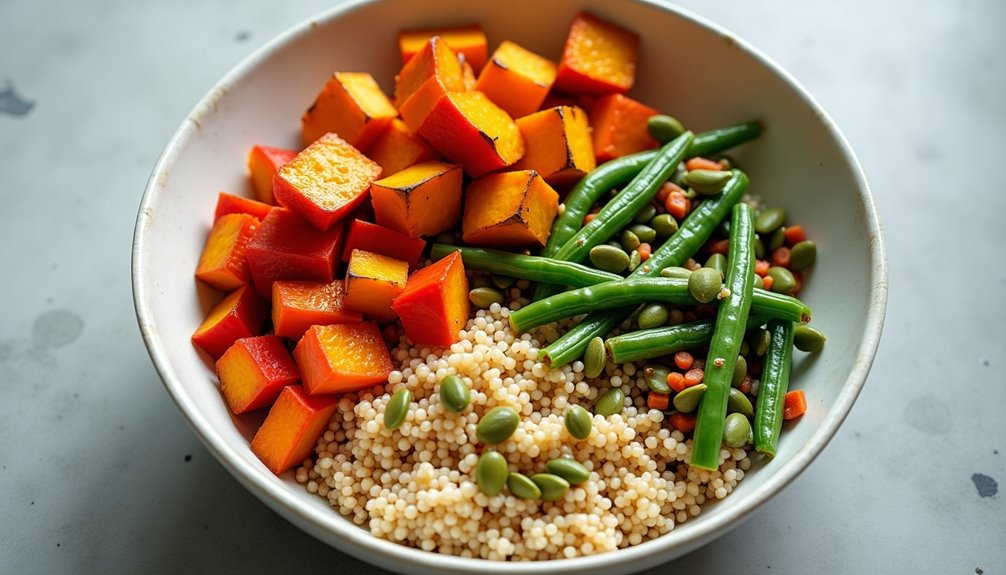
Quinoa and roasted vegetables combine to create a nourishing, gut-friendly meal that's both satisfying and easy to digest. This low FODMAP bowl delivers essential nutrients while being gentle on sensitive stomachs, making it an ideal choice for those following a FODMAP-conscious diet.
This versatile dish can be enjoyed warm or cold, making it perfect for meal prep and leftovers. The roasted vegetables develop a deep, caramelized flavor while the quinoa provides a complete protein source, ensuring you stay full and energized throughout the day.
Start by rinsing the quinoa thoroughly under cold water. Combine quinoa with water in a medium saucepan, bring to a boil, then reduce heat and simmer covered for 15-20 minutes until water is absorbed and quinoa is fluffy. While the quinoa cooks, preheat your oven to 400°F (200°C). Toss the chopped vegetables with olive oil, herbs, salt, and pepper on a large baking sheet. Roast for 25-30 minutes, stirring halfway through, until vegetables are tender and lightly caramelized.
To assemble, fluff the cooked quinoa with a fork and divide it into bowls. Top with the roasted vegetables, sprinkle with pumpkin seeds, and drizzle with apple cider vinegar. The dish can be served immediately or stored in airtight containers for up to 4 days.
For best results, cut vegetables into similarly sized pieces to ensure even roasting. If making ahead, store the quinoa and roasted vegetables separately to maintain optimal texture. You can also customize the seasonings to your preference, but avoid using garlic or onion to keep the dish low FODMAP compliant.
Ingredients:
- 1 cup quinoa
- 2 cups water
- 2 carrots, chopped
- 1 red bell pepper, diced
- 2 cups butternut squash, cubed
- 1 cup green beans, trimmed
- 3 tablespoons olive oil
- 1 teaspoon dried thyme
- 1 teaspoon dried rosemary
- 1/2 teaspoon sea salt
- 1/4 teaspoon black pepper
- 2 tablespoons pumpkin seeds
- 1 tablespoon apple cider vinegar
Grilled Steak With Roasted Potatoes

Grilled steak and roasted potatoes is a classic combination that's naturally low in FODMAPs, making it perfect for those with sensitive digestive systems. The simplicity of this dish allows the natural flavors to shine through, while providing a satisfying and protein-rich meal.
The key to this recipe lies in proper seasoning and cooking temperatures. A well-marbled steak paired with crispy, golden-brown potatoes creates a restaurant-quality meal that's both IBS-friendly and delicious.
Ingredients:
- 2 ribeye steaks (1-inch thick)
- 4 medium potatoes
- 3 tablespoons olive oil
- 1 tablespoon kosher salt
- 1 teaspoon black pepper
- 1 teaspoon dried rosemary
- 1 teaspoon dried thyme
- 2 tablespoons butter
- Fresh parsley for garnish
Preheat the oven to 425°F (220°C). Cut potatoes into 1-inch cubes and toss with olive oil, salt, pepper, rosemary, and thyme. Spread on a baking sheet and roast for 35-40 minutes, turning halfway through, until golden brown and crispy.
For the steak, remove it from the refrigerator 30 minutes before cooking to reach room temperature. Season generously with salt and pepper. Heat a grill or cast-iron skillet to high heat. Cook the steak for 4-5 minutes per side for medium-rare, adding butter in the last minute. Let rest for 10 minutes before slicing.
Temperature control is crucial for this dish. Use an instant-read thermometer to check the steak's doneness (135°F for medium-rare). For the potatoes, ensure they're evenly sized for uniform cooking, and don't overcrowd the baking sheet as this will cause them to steam rather than roast. If reheating leftovers, the steak is best served at room temperature to prevent overcooking.
Simple Greek Salad
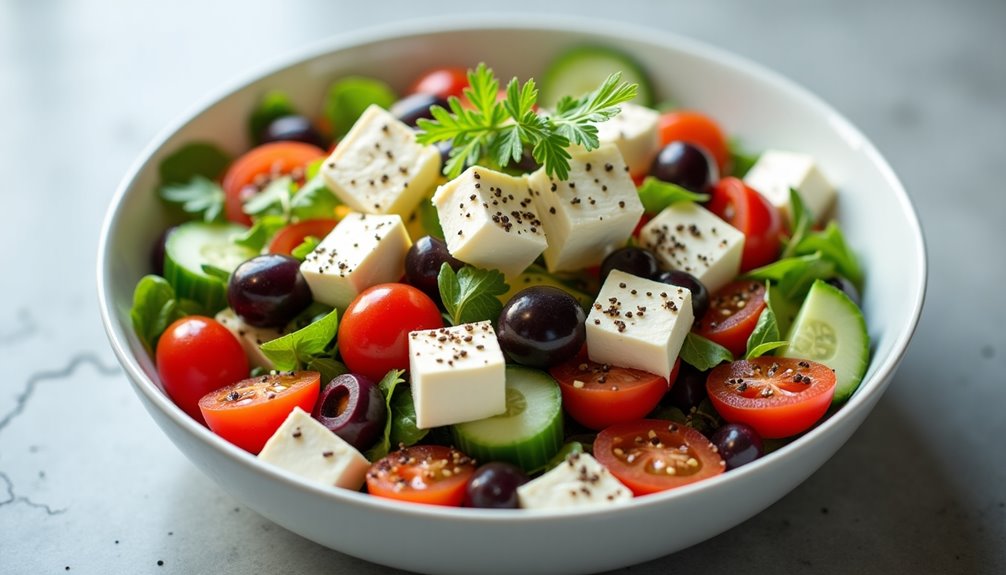
This version eliminates common FODMAP triggers like onions and garlic while maintaining the authentic Mediterranean taste. The salad can be prepared in minutes and serves as an ideal side dish or light main course, especially during warmer months.
Ingredients:
- 3 medium tomatoes, cut into wedges
- 1 English cucumber, sliced
- 1 green bell pepper, chopped
- 1/2 cup Kalamata olives
- 200g feta cheese, cubed
- 2 tablespoons extra virgin olive oil
- 1 tablespoon red wine vinegar
- 1 teaspoon dried oregano
- Salt and black pepper to taste
- Fresh oregano leaves for garnish (optional)
Start by washing and chopping all vegetables into bite-sized pieces. The tomatoes should be cut into wedges, the cucumber into half-moons, and the bell pepper into chunks roughly the same size. Place all chopped vegetables in a large serving bowl.
Add the Kalamata olives and cubed feta cheese to the bowl. In a separate small bowl, whisk together the olive oil, red wine vinegar, dried oregano, salt, and pepper. Pour this dressing over the salad ingredients and toss gently to combine, being careful not to break up the feta cheese too much.
For best results, chill the salad for 15-30 minutes before serving to allow the flavors to meld together. The salad can be stored in an airtight container in the refrigerator for up to 24 hours, though it's best enjoyed fresh. If preparing in advance, consider adding the feta cheese and dressing just before serving to maintain optimal texture and prevent the vegetables from becoming too soggy.
Low FODMAP Smoothie Bowl

A smoothie bowl is a perfect low FODMAP breakfast option that combines the refreshing qualities of a smoothie with the satisfying experience of eating from a bowl with various toppings. This recipe ensures all ingredients are FODMAP-friendly while maintaining excellent nutritional value and taste.
The key to creating a successful low FODMAP smoothie bowl lies in selecting the right fruits and add-ins that won't trigger digestive issues. This recipe uses strawberries and blueberries as the base, which are both low FODMAP fruits when consumed in appropriate portions.
Ingredients:
- 1 cup strawberries, frozen
- 1/2 cup blueberries, frozen
- 1 medium banana, frozen
- 1/2 cup lactose-free yogurt
- 1/4 cup lactose-free milk
- 1 tablespoon chia seeds
- 1 tablespoon maple syrup (optional)
Toppings:
- 2 tablespoons gluten-free granola
- Fresh strawberry slices
- 1 tablespoon pumpkin seeds
- 1 teaspoon shredded coconut
Add all smoothie ingredients except the toppings to a high-powered blender. Blend on high speed until smooth and creamy, stopping occasionally to scrape down the sides. The consistency should be thicker than a regular smoothie – you may need to adjust the amount of milk to achieve the desired thickness.
Pour the smoothie mixture into a bowl and arrange the toppings in sections for an aesthetically pleasing presentation. Start with the granola, then add fresh fruit slices, and finish with a sprinkle of pumpkin seeds and coconut. Serve immediately while the smoothie is still cold and thick.
For best results, freeze your fruits at least 6 hours before making the smoothie bowl. If your smoothie becomes too thick during blending, add more lactose-free milk one tablespoon at a time. Avoid using room temperature fruits as this will result in a thin consistency that won't hold up the toppings properly.


